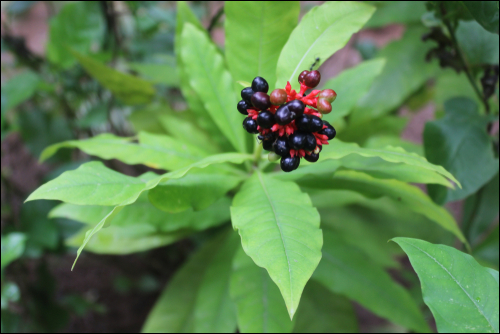Sarpagandha / Rauvolfia serpentina – Classification, Ayurvedic Properties & Dosage
Description
Sarpagandha (Rauwolfia serpentina) is a famous Tranquilizer and Antipsychotic herb and is useful in controlling Hypertension. Sarpagandha is an erect, evergreen shrub which grows up to a height of 15-45 cm. The leaves of Sarpagandha are large, from dark green to pale green in colour. Its scientific name is Rauwolfia Serpentina. The roots of this herb are tuberous with a brown cork. Its flowers are white in colour and contain nectar in deep corolla tubes. Fruits are oval and is fleshy which turns purple and black on ripening. Commonly found in India and Pakistan and is well distributed in the regions of the Sub Himalayan tract from Punjab to Nepal. Found in Moist Deciduous forests and in shady regions at the height of 4000 above sea level. Well known as Nakuli in Sanskrit. The phyto-constituents which are present in this plant are Reserpiline, Serpentine, and Ajmaline. Reserpine is a useful alkaloid of this plant.
- Botanical name – Rauvolfia serpentina
- Family – Apocynaceae

Synonyms
- Sarpgandha – Sarpaan gandhyati ardyati iti – one who afflicts snakes and drives them away.
- Dhavalavitapa – Dhawati shodhyati mano dehamcha iti dhawal – the herb that cleanses and purifies the body and mind.
- Chandramara – Chandramaahlaadam maaryati – chandra word refers to mind, this herb helps in relieving the tension of mind.
- Naakuli
- Sarpasugandha
- Sugandha
- Mukta
- Nakuleshta
Other Vernacular Names
- In Hindi – It is commonly named as chota chand, nakuli kand, dhawal barua
- In English – It is called as sepentina root, Rauvolfia root, indian snakeroot.
- In Bihar – Dhanmarva, chandmarva, dhavalbarua
- In Tamil, Malyalam – Chivan amalpodi
Classical Categorisation
- Sushrut Samhita – Aparajita Gana
- Dhanwantri Nighantu – Karveeradi varga
- Priynighantu – Shatpushpadi varga
- Shodhal Nighantu – Guduchyadi Varga, karveeradi varga
- PV Sharma – Rakshoghana Dharaneeya gana, kutaja kula
Morphology
- Sarpagandha is an erect, evergreen shrub, merely 15 to 45 cm high.
- Its leaves are large, in whorls of three – dark green above and pale green below.
- Its flowers are white, pinkish or red, occurring in whorls.
- Its fruits are tiny, oval, fleshy which turn a shiny purple-black when ripe.
- It is the roots of the plant that are mainly used for medicinal purposes.
Rasa Panchak
- Rasa (Taste) – Tikta (Bitter)
- Guna (Qualities) – Ruksha (dry in nature)
- Vipaka (after digestion) – katu (pungent)
- Veerya (Potency) – hot (ushna)
- Effects on doshas – balances Vata and Kapha Dosha
- Prabhava – Nidrajanak (induces sleep)
Benefits
- Sarpagandha or black snake root is one of the very important Ayurvedic herbs, it is used in treating the hypertensive conditions or sleeplessness.
- It is effective Vranahara – Heals the wound quickly.
- Krimihara – Relieve worm infestation, or infection.
- Removes the toxic effect of rodent bites. Useful in the treatment of insect bites, scorpion bites, rat bites etc.
- Vishama Jwara – Useful in recurrent and chronic fever.
- Sarpagandha has a calming effect over the mind and brain that helps by induces sleep. It also helps in relieving the excited state of the mind so is very useful in schizophrenia.
- It helps in reducing the blood pressure.
- It contracts the uterus and induces menstruation.
- It is used in the management of epilepsy, panic attacks and anxiety.
- Used in treatment of premature ejaculation.
Chemical Composition
- Ajmalicine, Indobinine, Serpentinine,
Reserpine, serpentine, ajmaline etc. - Reserpine is the antihypertensive principle having tranquillizing property also.
- Ajmaline is used in the treatment of hypertension complicated with arrhythmia.
Part Used
Roots
Dosage
- In Insomnia conditions 250 to 1000 mg can be used in divided doses.
- In hypertensive patients 250 to 2000 mg in divided doses.
- In schizophrenia 500 to 4000 mg in divided doses, it is the maximum dosage.
- In hysteria 1000mg with cow milk.
Internal Use
- In insomnia its root powder can be given with cowghee.
- In gastrointestinal diseases it can be given with sapagandha, kutaja bark skin, and eranda roots in 1:2:3 proportion and given with milk.
- In hypertension, the paste of its roots mixed with rose helps to relieve mental stress, headache, and induces sound sleep.
- The decoction of the root to increase the uterine contraction.
- In snake bite root powder 10-20 mg given with water.
- In hysteria root powder can be taken with cow milk.
Formulations
- Sarpgandha Powder
- Sarpgandhaghan Vati



